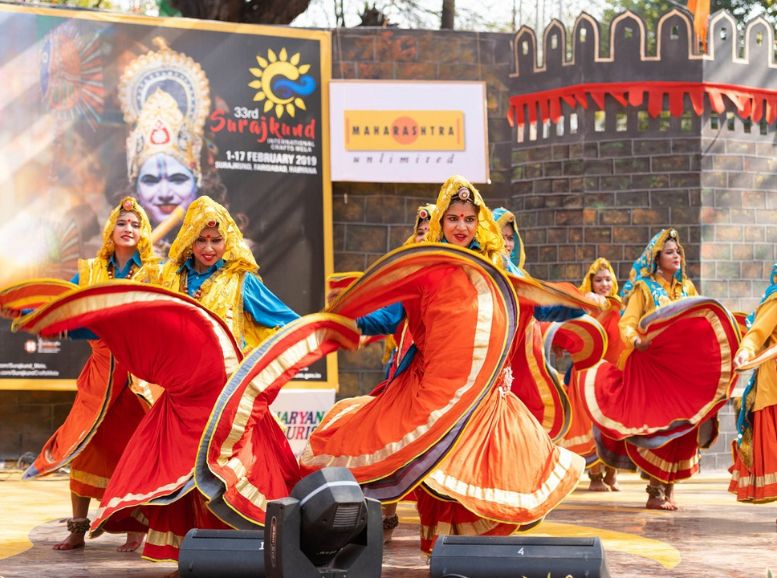Haryana bursts into color each year with the Surajkund Mela, a vibrant celebration of Indian artistry. Held near the historic Surajkund reservoir, this annual event is a captivating showcase of craftsmanship, tradition, and the enduring spirit of community. For decades, the Mela has served as a platform for artisans to display their skills, musicians to weave their magic, and visitors to lose themselves in the dazzling tapestry of Indian culture. As the sun bathes the Mela grounds in its golden light, it illuminates a unique space where age-old traditions intertwine with contemporary expressions, creating a symphony of past, present, and vibrant colors. Embark with us on a fascinating exploration of the Surajkund Mela, a treasure trove where every corner pulsates with the rhythm of India’s rich heritage and artistic brilliance.
Hoe to reach:
- Air: Indira Gandhi International Airport (IGI Airport) in Delhi, roughly 25 kilometers away, is the closest airport. Hire a taxi or use ride-hailing services upon arrival to reach the Mela grounds directly.
- Train: Faridabad Railway Station serves as the nearest train station, offering connections to major cities like Delhi, Gurgaon, and Agra. From the station, taxis and local buses can take you to the Surajkund Mela venue.
- Road: Surajkund Mela is conveniently accessible by road, situated near Surajkund-Badkhal Road in Faridabad, Haryana. You can drive your own vehicle, hire a taxi from nearby cities like Delhi, Gurgaon, or Noida, or take advantage of the well-connected road network. Ample parking is available at the venue.
- Public Transport: State-run and private buses offer regular service to Faridabad from various cities in Haryana and neighboring states. Upon reaching Faridabad bus stand, connect to the Surajkund Mela venue via local bus or auto-rickshaw.
Best time to visit:
- Winter (February): The Surajkund Mela coincides with the first two weeks of February, making it the prime time for a visit. Pleasant weather with cooler temperatures compared to summer allows for comfortable exploration of the Mela grounds.
- Spring (March): As the Mela often bridges the winter and spring seasons, March offers delightful weather. Mild days and pleasant evenings create an ideal atmosphere to experience the Mela’s vibrancy.
- Early Summer (April): While the weather starts to warm up in April, early April can still be enjoyable, especially during the initial days of the Mela. Milder mornings and evenings allow for comfortable exploration before the peak heat arrives.
Attractions:
Crafts Pavilion: Surajkund Mela
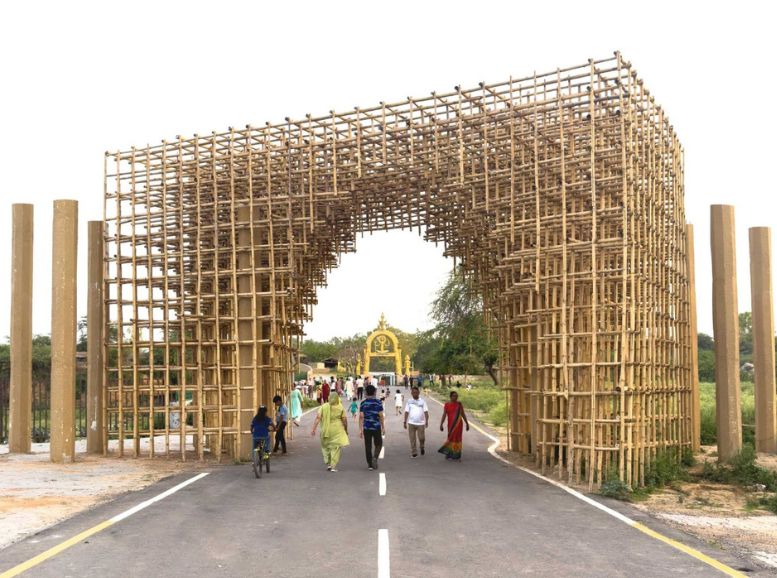
Immerse yourself in the vibrant Crafts Pavilion, a treasure trove where artisans from every corner of India unveil their time-honored crafts. From the intricate patterns of handloom textiles to the earthy tones of pottery, the skilled hands of these artists bring generations-old techniques to life. Witness the creation of exquisite woodwork, marvel at the gleaming metalware, and lose yourself in the artistry. Each piece here transcends mere function; it becomes a captivating story, whispering tales of heritage and the cultural essence of its region.
Cultural Performances:
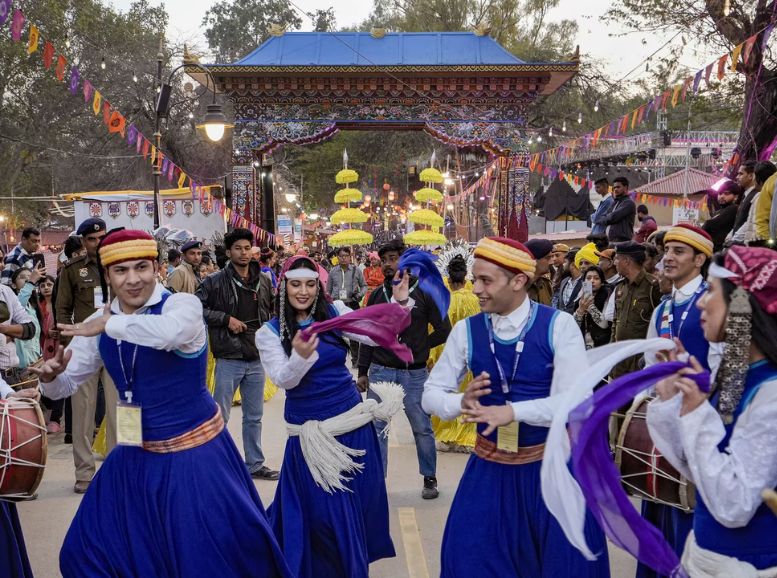
Immerse yourself in the vibrant kaleidoscope of Indian culture through enthralling folk music, dance, and theater performances. Witness the rich tapestry of the nation’s heritage come alive as artists from various states showcase their unique art forms on open-air stages. Let the rhythmic beats of folk drums pulsate through you, be captivated by the graceful movements of dancers adorned in dazzling attire, and lose yourself in the captivating narratives woven through theatrical presentations. Each performance serves as a vibrant portal into the heart of India, leaving you spellbound and brimming with inspiration.
Street Performers:
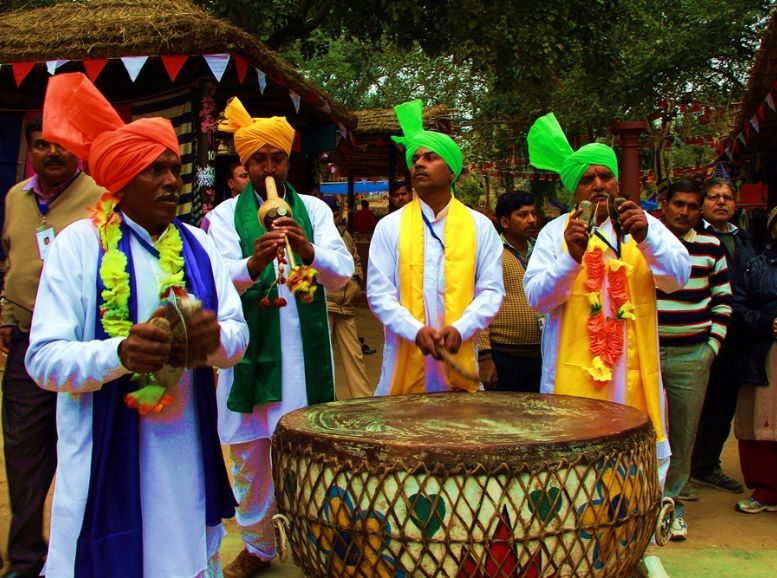
The festive spirit of the Surajkund Mela spills over into electrifying street performances. Witness talented artists weave magic that bends reality, be captivated by the whimsical narratives brought to life through puppetry, and marvel at the acrobatic feats that seem to defy gravity. From the playful interactions of magicians to the awe-inspiring agility of acrobats, these captivating performances transform the Mela grounds into a vibrant stage, adding another layer of energy and delight to the experience.
International Participation:
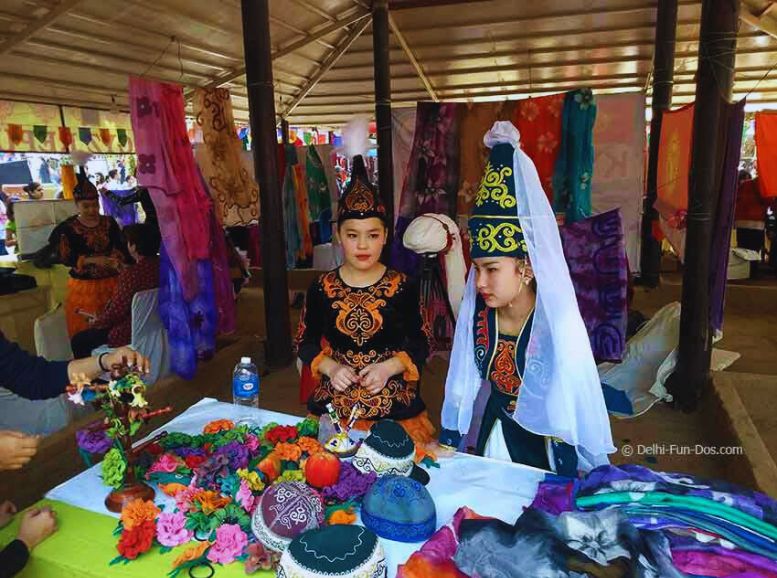
The Surajkund Mela transcends borders, offering a taste of the world within its vibrant grounds. At the International Pavilion, embark on a cultural odyssey without leaving India. Here, artisans and performers from various nations weave a tapestry of international artistry. Explore the captivating displays of indigenous crafts, lose yourself in the melodies of global music, and witness the mesmerizing grace of traditional dance forms from around the world. This unique platform fosters a spirit of cultural exchange, allowing you to broaden your horizons and discover the artistic essence of various countries.
Local experiences:
- Unwind at Surajkund Lake: Take a peaceful stroll around the picturesque Surajkund Lake, namesake of the Mela. Immerse yourself in the serene ambiance, enjoy scenic views, and keep an eye out for birds while exploring the shoreline.
- Step Back in Time at Anangpur Dam: Unearth the region’s rich heritage at the historic Anangpur Dam, situated close to the Mela grounds. This ancient reservoir, believed to be from the 8th century, offers a glimpse into architectural marvels of the past.
- Shop Local at Surajkund Market: Delve into the lively Surajkund Market, a treasure trove located near the Mela grounds. Here, you can shop for unique local handicrafts, textiles, and souvenirs. Interact with friendly vendors and artisans, and perhaps bargain for a piece of tradition to take home.
- Experience Rural Charm: For a unique perspective, venture beyond the Mela and immerse yourself in rural life at nearby villages. Visit traditional homes, connect with locals, and gain firsthand knowledge about rural customs, agricultural practices, and artisanal techniques.
- Immerse Yourself in Local Culture: During your visit, explore cultural events and festivals taking place in nearby villages or towns. Witness the vibrancy of rural celebrations, be captivated by folk performances, and experience traditional rituals that offer a window into the soul of the local culture.
- Savor Haryanvi Delights: Indulge in authentic Haryanvi cuisine at local eateries and dhabas near Surajkund. Savor traditional dishes like kadhi, baingan bharta, bajra roti, and more, all prepared using fresh local ingredients and traditional cooking methods.
Travel tips:
- Do Your Research: Check the official sources for the confirmed dates and schedule of the Surajkund Mela before finalizing your trip. Consider visiting on weekdays to avoid peak crowds that tend to gather on weekends.
- Beat the Rush: Arrive early in the morning to explore the Mela comfortably. Popular attractions tend to get crowded later in the day, so an early start allows you to experience them at your own pace.
- Dress for Comfort: Opt for comfortable, lightweight clothing suitable for warm weather. Consider carrying a hat, sunglasses, and sunscreen for sun protection throughout the day.
- Stay Hydrated: Pack a reusable water bottle and stay hydrated, especially if you plan to spend a significant amount of time exploring the Mela grounds. Refreshing beverages are also available at stalls within the venue.
- Cash is King: While some vendors may accept digital payments, it’s wise to carry enough cash for purchases like handicrafts, food, and other items at the Mela stalls.
- Negotiate Savvy: Bargaining is an integral part of the Mela experience. Engage in friendly negotiations to get the best deals on handicrafts and souvenirs, but remember to be respectful throughout the process.
- Practice Good Hygiene: Maintain personal hygiene by carrying hand sanitizer or wet wipes. Utilize the restroom facilities available on-site and dispose of waste responsibly.
- Be Security-Conscious: Keep a watchful eye on your belongings, especially in crowded areas. Be aware of your surroundings and take precautions against pickpockets.
Conclusion
The Surajkund Mela in Haryana pulsates with the vibrant essence of India’s artistic heritage and cultural tapestry. Each year, this dazzling spectacle transforms into a stage showcasing the nation’s finest handicrafts, textiles, and culinary delights. It fosters a space for cultural exchange and joyous celebration, captivating visitors with immersive experiences and an electrifying atmosphere. From witnessing enthralling performances to engaging with local communities, the Surajkund Mela leaves an indelible mark. As visitors depart, they carry a kaleidoscope of memories – the echo of music, the intricate details of handcrafted treasures, and a newfound appreciation for Indian culture. Whether it’s navigating the bustling marketplace, savoring regional delicacies, or interacting with artisans and performers, the Surajkund Mela offers an unparalleled journey into the heart of India. As the sun dips below the horizon, marking the end of another successful edition, the Mela leaves behind a legacy of tradition, artistry, and community spirit. It serves as a powerful reminder to cherish and preserve India’s cultural heritage for generations to come.
Plan Your Surajkund Mela Adventure with Xplro.com.
FAQ
- What is the Surajkund Mela?
- The Surajkund Mela is an annual cultural fair held in Haryana, India, renowned for showcasing traditional handicrafts, textiles, and cultural performances.
- Where is the Surajkund Mela held?
- The Surajkund Mela takes place near the historic Surajkund reservoir in Faridabad, Haryana, situated approximately 8 kilometers from South Delhi.
- When is the Surajkund Mela held?
- The Surajkund Mela is typically held during the first two weeks of February each year, coinciding with the spring season.
- What is the significance of the Surajkund Mela?
- The Surajkund Mela holds significant cultural importance as it celebrates India’s rich heritage, promotes traditional craftsmanship, and fosters cultural exchange among artisans and visitors.
- How long has the Surajkund Mela been held?
- The Surajkund Mela has been an annual event since its inception in 1987, making it one of India’s oldest and most celebrated cultural fairs.
- What can visitors expect to see at the Surajkund Mela?
- Visitors can expect to see a diverse range of traditional handicrafts, including pottery, textiles, woodwork, metalware, along with cultural performances, food stalls, and interactive workshops.
- Is there an entry fee for the Surajkund Mela?
- Yes, there is an entry fee for the Surajkund Mela, which varies for adults, children, and foreign tourists. However, certain categories of visitors may be eligible for free entry.
- Are there parking facilities available at the Surajkund Mela?
- Yes, there are ample parking facilities provided near the Surajkund Mela grounds, catering to cars, motorcycles, and buses.
- Can visitors purchase handicrafts and souvenirs at the Surajkund Mela?
- Absolutely! Visitors have the opportunity to purchase a wide array of handicrafts, textiles, jewelry, home decor items, and souvenirs from the numerous stalls and pavilions.
- Are accommodations available nearby during the Surajkund Mela?
- Yes, there are various accommodations such as hotels, guesthouses, and resorts located in close proximity to the Surajkund Mela grounds, catering to the lodging needs of visitors.
- Is the Surajkund Mela accessible to differently-abled individuals?
- Yes, the Surajkund Mela grounds are designed to be wheelchair accessible, with provisions such as ramps and designated pathways to facilitate the movement of differently-abled individuals.
- Are there any restrictions on photography at the Surajkund Mela?
- While photography for personal use is generally allowed, visitors are advised to respect the privacy of artisans and performers and seek permission before photographing them.




